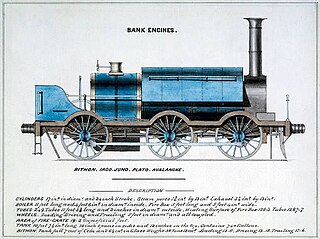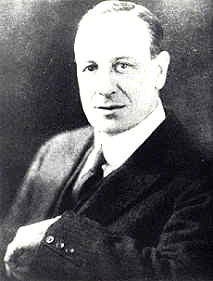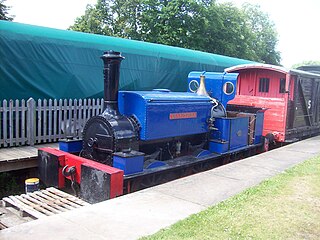
A Fairlie locomotive is a type of articulated steam locomotive that has the driving wheels on bogies. The locomotive may be double-ended or single ended.

Under the Whyte notation for the classification of steam locomotives, 0-4-0 represents one of the simplest possible types, that with two axles and four coupled wheels, all of which are driven. The wheels on the earliest four-coupled locomotives were connected by a single gear wheel, but from 1825 the wheels were usually connected with coupling rods to form a single driven set.

The Hunslet Engine Company is a locomotive building company, founded in 1864 in Hunslet, England. It manufactured steam locomotives for over 100 years and currently manufactures diesel shunting locomotives. The company owns a substantial fleet of Industrial and depot shunting locomotives which are available for hire. The company is part of Ed Murray & Sons Ltd.

The first Locomotives of the Great Western Railway (GWR) were specified by Isambard Kingdom Brunel but Daniel Gooch was soon appointed as the railway's Locomotive Superintendent. He designed several different 7 ft 1⁄4 in broad gauge types for the growing railway, such as the Firefly and later Iron Duke Class 2-2-2s. In 1864 Gooch was succeeded by Joseph Armstrong who brought his standard gauge experience to the workshops at Swindon. To replace some of the earlier locomotives, he put broad gauge wheels on his standard gauge locomotives and from this time on all locomotives were given numbers, including the broad gauge ones that had previously carried just names.

The Banking Class were five 0-6-0ST Brunel gauge steam locomotives for assisting ("banking") trains up inclines on the Great Western Railway. Designed by Daniel Gooch, they were tank engine versions of his Standard Goods class, and mainly built at Swindon Works.

The Hunslet Austerity 0-6-0ST is a class of steam locomotive designed by Hunslet Engine Company for shunting. The class became the standard British shunting locomotive during the Second World War, and production continued until 1964 at various locomotive manufacturers.

Charles Benjamin Collett was Chief Mechanical Engineer of the Great Western Railway from 1922 to 1941. He designed the GWR's 4-6-0 Castle and King Class express passenger locomotives.

W. G. Bagnall was a locomotive manufacturer from Stafford, England which was founded in 1875 and operated until it was taken over in 1962 by English Electric.

Manning Wardle was a steam locomotive manufacturer based in Hunslet, Leeds, West Yorkshire, England.

GWR No. 1340 is an 0-4-0ST steam locomotive, built in 1897 by the Avonside Engine Company of Bristol, England.

The Burry Port and Gwendraeth Valley Railway (BP&GV) numbers 4 Kidwelly and 5 Cwm Mawr were small 0-6-0ST steam locomotives, originally built by the Avonside Engine Company in May 1903 and April 1905 respectively.
The West Cornwall Railway was a railway company in Cornwall, Great Britain, formed in 1846 to construct a railway between Penzance and Truro. It purchased the existing Hayle Railway, and improved its main line, and built new sections between Penzance and Hayle, and between Redruth and Truro, and opened throughout in 1852.
The Comet class were 12 4-4-0ST broad gauge locomotives operated on the South Devon Railway and associated railways. They were designed for passenger trains on this steep and sharply curved line but were also used on goods trains when required.

The Bristol and Exeter Railway locomotives worked trains on the Bristol and Exeter Railway from 1 May 1849 until the railway was amalgamated with the Great Western Railway on 1 January 1876.
The Bristol and Exeter Railway 0-6-0 locomotives include three different types of broad gauge and standard gauge 0-6-0 steam locomotives designed for working freight trains. On 1 January 1876 the Bristol and Exeter Railway was amalgamated with the Great Western Railway, after which the locomotives were given new numbers.
Vale of Neath Railway 0-6-0ST locomotives were 0-6-0ST steam locomotives for working the heavy goods traffic on the Vale of Neath Railway and its associated lines in Wales. The first of 13 broad gauge locomotives entered service in 1854 and the last was withdrawn in 1886. The remaining four were standard gauge locomotives.

Rolvenden railway station is a heritage railway station on the Kent and East Sussex Railway in Tenterden, Kent, in the United Kingdom.
The Avonside Locomotive Works was a locomotive manufacturer on Filwood Road, Fishponds, Bristol, England. A nearby locomotive builder was Peckett and Sons located on Deep Pit Road between Fishponds and St George.
Great Western Railway absorbed locomotives gives details of Great Western Railway absorbed locomotives which do not yet have individual pages.















